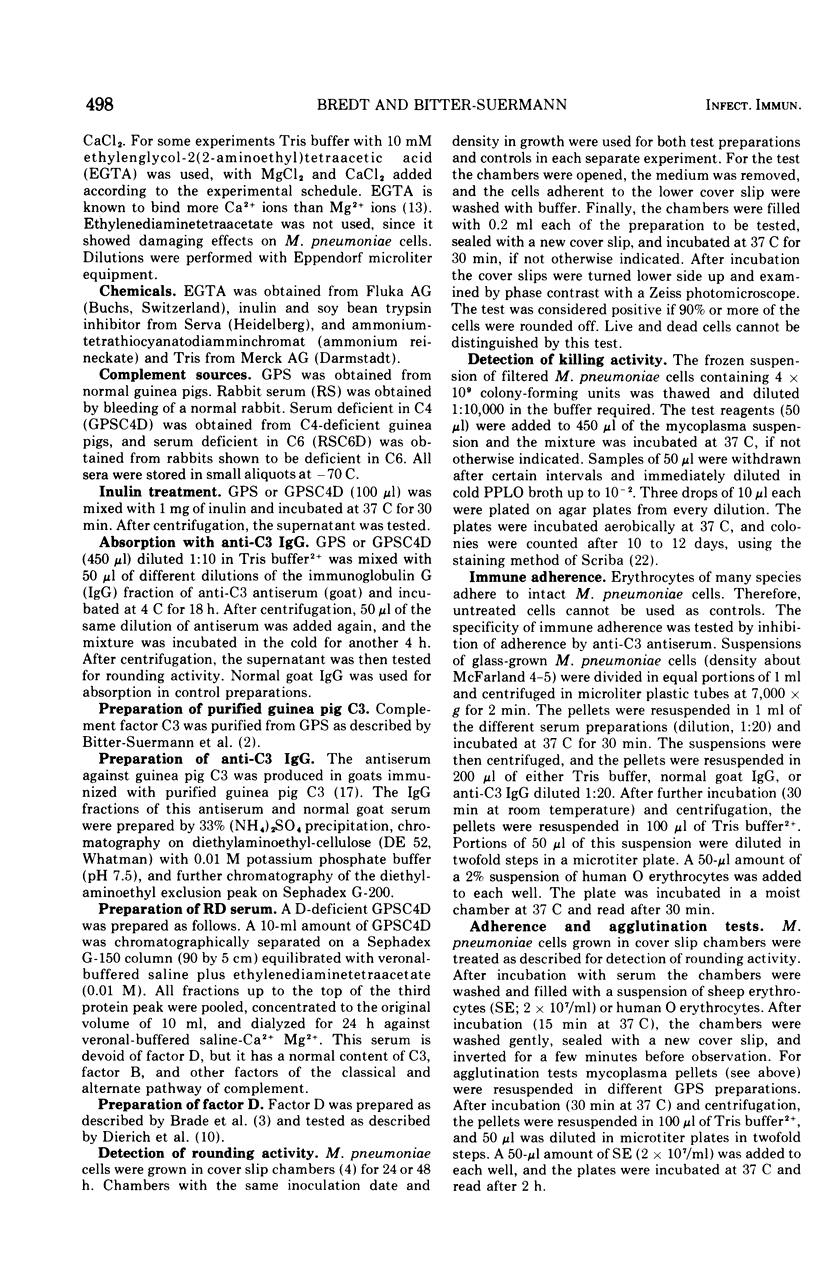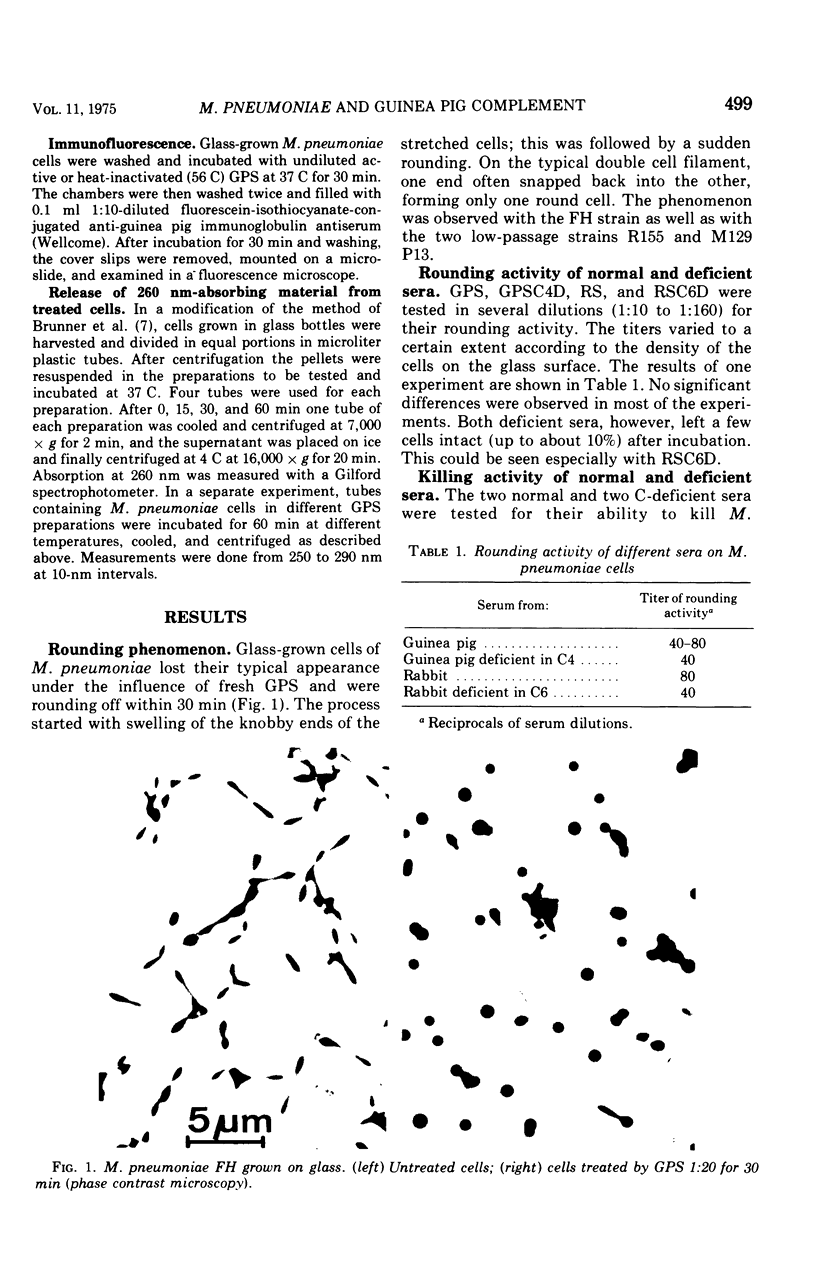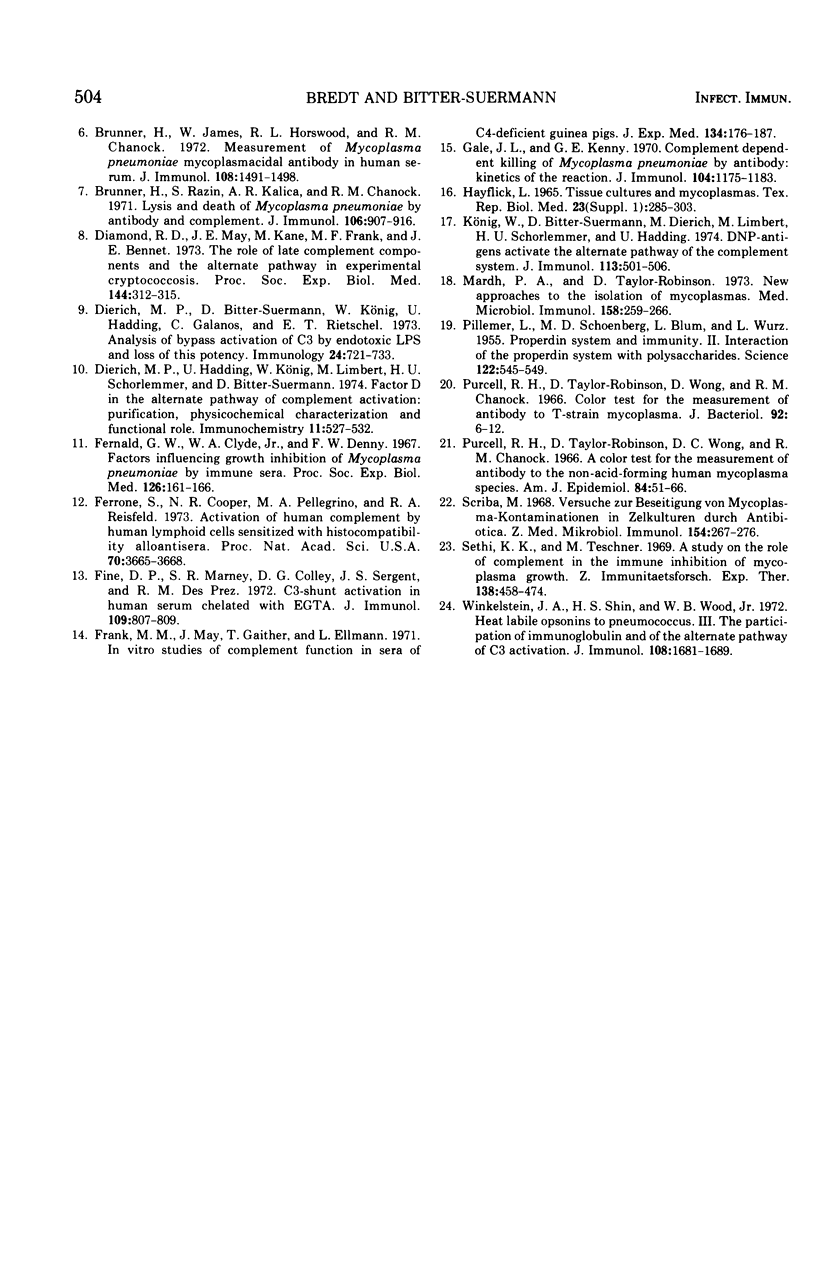Abstract
The "toxic" effect of guinea pig serum (GPS) on Mycoplasma pneumoniae cells was tested under various conditions, using rounding and killing of the cells as test systems. Both activities could be inhibited by heat inactivation (56 C, 30 min). Killing required both Ca2+ and Mg2+, rounding only Mg2+. Both activities were temperature dependent and no rounding or killing occurred at 4C. Incomplete complement sequences with natural of artificial defects in C1, C4, or C6 resulted in lost or reduced killing. The rounding activity was only slightly affected. Anti-C3 antiserum blocked both phenomena; incubation of GPS with 10 mg of inulin per ml reduced the rounding activity, and the same treatment of GPS deficient in C4 inhibited rounding totally. Properdin factor D was shown to be necessary for rounding by GPS, with defects in either C1 or C4. By immune adherence bound C3b could be demonstrated on M. pneumoniae cells after GPS treatment, no antibodies against M. pneumoniae could be found in GPS by immune fluorescence. The results give evidence for complement being the toxic factor in GPS. Efficient killing requires the intact complement sequence. Furthermore, M. pneumoniae cells are able to activate the alternate pathway of complement. Activation of this pathway results in rounding of the cells, which are partly able to recover after this reaction. Biological consequences for the mycoplasmas are death or damage and possibly opsonization, even in the absence of specific antibodies. The host, too, is possibly affected by products of the reaction. The interaction of M. pneumoniae and complement could be involved in the early stages of the development of M. pneumoniae disease.
Full text
PDF







Images in this article
Selected References
These references are in PubMed. This may not be the complete list of references from this article.
- Barker L. F., Patt J. K. Role of complement in immune inactivation of Mycoplasma gallisepticum. J Bacteriol. 1967 Aug;94(2):403–408. doi: 10.1128/jb.94.2.403-408.1967. [DOI] [PMC free article] [PubMed] [Google Scholar]
- Bitter-Suermann D., Hadding U., Melchert F., Wellensiek H. J. Independent and consecutive action of the complement components C5, C6 and C7 in immune hemolysis. I. Preparation of EAC1-5 with purified guinea pig C3 and C5. Immunochemistry. 1970 Dec;7(12):955–965. doi: 10.1016/0019-2791(70)90002-9. [DOI] [PubMed] [Google Scholar]
- Brade V., Nicholson A., Lee G. D., Mayer M. M. The reaction of zymosan with the properdin system: isolation of purified factor D from guinea pig serum and study of its reaction characteristics. J Immunol. 1974 May;112(5):1845–1854. [PubMed] [Google Scholar]
- Bredt W. A microscopic test for rapid detection of antibodies against Mycoplasma pneumoniae. Experientia. 1969 Apr 15;25(4):436–437. doi: 10.1007/BF01899972. [DOI] [PubMed] [Google Scholar]
- Bredt W. Growth morphology of Mycoplasma pneumoniae strain FH on glass surface. Proc Soc Exp Biol Med. 1968 Jun;128(2):338–340. doi: 10.3181/00379727-128-33009. [DOI] [PubMed] [Google Scholar]
- Brunner H., James W. D., Horswood R. L., Chanock R. M. Measurement of Mycoplasma pneumoniae mycoplasmacidal antibody in human serum. J Immunol. 1972 Jun;108(6):1491–1498. [PubMed] [Google Scholar]
- Brunner H., Razin S., Kalica A. R., Chanock R. M. Lysis and death of Mycoplasma pneumoniae by antibody and complement. J Immunol. 1971 Apr;106(4):907–916. [PubMed] [Google Scholar]
- Diamond R. D., May J. E., Kane M., Frank M. M., Bennett J. E. The role of late complement components and the alternate complement pathway in experimental cryptococcosis. Proc Soc Exp Biol Med. 1973 Oct 1;144(1):312–315. doi: 10.3181/00379727-144-37580. [DOI] [PubMed] [Google Scholar]
- Dierich M. P., Bitter-Suermann D., König W., Hadding U., Galanos C., Rietschel E. T. Analysis of bypass activation of C3 by endotoxic LPS and loss of this potency. Immunology. 1973 Apr;24(4):721–733. [PMC free article] [PubMed] [Google Scholar]
- Dierich M. P., Hadding U., König W., Limbert M., Schorlemmer H. U., Bitter-Suermann D. Factor D in the alternate pathway of complement activation: purification, physicochemical characterization and functional role. Immunochemistry. 1974 Sep;11(9):527–532. doi: 10.1016/0019-2791(74)90242-0. [DOI] [PubMed] [Google Scholar]
- Fernald G. W., Clyde W. A., Jr, Denny F. W. Factors influencing growth inhibition of Mycoplasma pneumoniae by immune sera. Proc Soc Exp Biol Med. 1967 Oct;126(1):161–166. doi: 10.3181/00379727-126-32391. [DOI] [PubMed] [Google Scholar]
- Ferrone S., Cooper N. R., Pellegrino M. A., Reisfeld R. A. Activation of human complement by human lymphoid cells sensitized with histocompatibility alloantisera. Proc Natl Acad Sci U S A. 1973 Dec;70(12):3665–3668. doi: 10.1073/pnas.70.12.3665. [DOI] [PMC free article] [PubMed] [Google Scholar]
- Fine D. P., Marney S. R., Jr, Colley D. G., Sergent J. S., Des Prez R. M. C3 shunt activation in human serum chelated with EGTA. J Immunol. 1972 Oct;109(4):807–809. [PubMed] [Google Scholar]
- Frank M. M., May J., Gaither T., Ellman L. In vitro studies of complement function in sera of C4-deficient guinea pigs. J Exp Med. 1971 Jul 1;134(1):176–187. doi: 10.1084/jem.134.1.176. [DOI] [PMC free article] [PubMed] [Google Scholar]
- Gale J. L., Kenny G. E. Complement dependent killing of Mycoplasma pneumoniae by antibody: kinetics of the reaction. J Immunol. 1970 May;104(5):1175–1183. [PubMed] [Google Scholar]
- Hayflick L. Tissue cultures and mycoplasmas. Tex Rep Biol Med. 1965 Jun;23(Suppl):285+–285+. [PubMed] [Google Scholar]
- König W., Bitter-Suermann D., Dierich M., Limbert M., Schorlemmer H. U., Hadding U. DNP-antigens activate the alternate pathway of the complement system. J Immunol. 1974 Aug;113(2):501–506. [PubMed] [Google Scholar]
- Mårdh P. A., Taylor-Robinson D. New approaches to the isolation of mycoplasmas. Med Microbiol Immunol. 1973;158(4):259–266. doi: 10.1007/BF02121412. [DOI] [PubMed] [Google Scholar]
- PILLEMER L., SCHOENBERG M. D., BLUM L., WURZ L. Properdin system and immunity. II. Interaction of the properdin system with polysaccharides. Science. 1955 Sep 23;122(3169):545–549. doi: 10.1126/science.122.3169.545. [DOI] [PubMed] [Google Scholar]
- Purcell R. H., Taylor-Robinson D., Wong D. C., Chanock R. M. A color test for the measurement of antibody to the non-acid-forming human Mycoplasma species. Am J Epidemiol. 1966 Jul;84(1):51–66. doi: 10.1093/oxfordjournals.aje.a120627. [DOI] [PubMed] [Google Scholar]
- Purcell R. H., Taylor-Robinson D., Wong D., Chanock R. M. Color test for the measurement of antibody to T-strain mycoplasmas. J Bacteriol. 1966 Jul;92(1):6–12. doi: 10.1128/jb.92.1.6-12.1966. [DOI] [PMC free article] [PubMed] [Google Scholar]
- Sethi K. K., Teschner M. A study on the role of complement in the immune inhibition of mycoplasmal growth. Z Immunitatsforsch Allerg Klin Immunol. 1969 Nov;138(5):458–474. [PubMed] [Google Scholar]
- Winkelstein J. A., Shin H. S., Wood W. B., Jr Heat labile opsonins to Pneumococcus. 3. The participation of immunoglobulin and of the alternate pathway of C3 activation. J Immunol. 1972 Jun;108(6):1681–1689. [PubMed] [Google Scholar]



